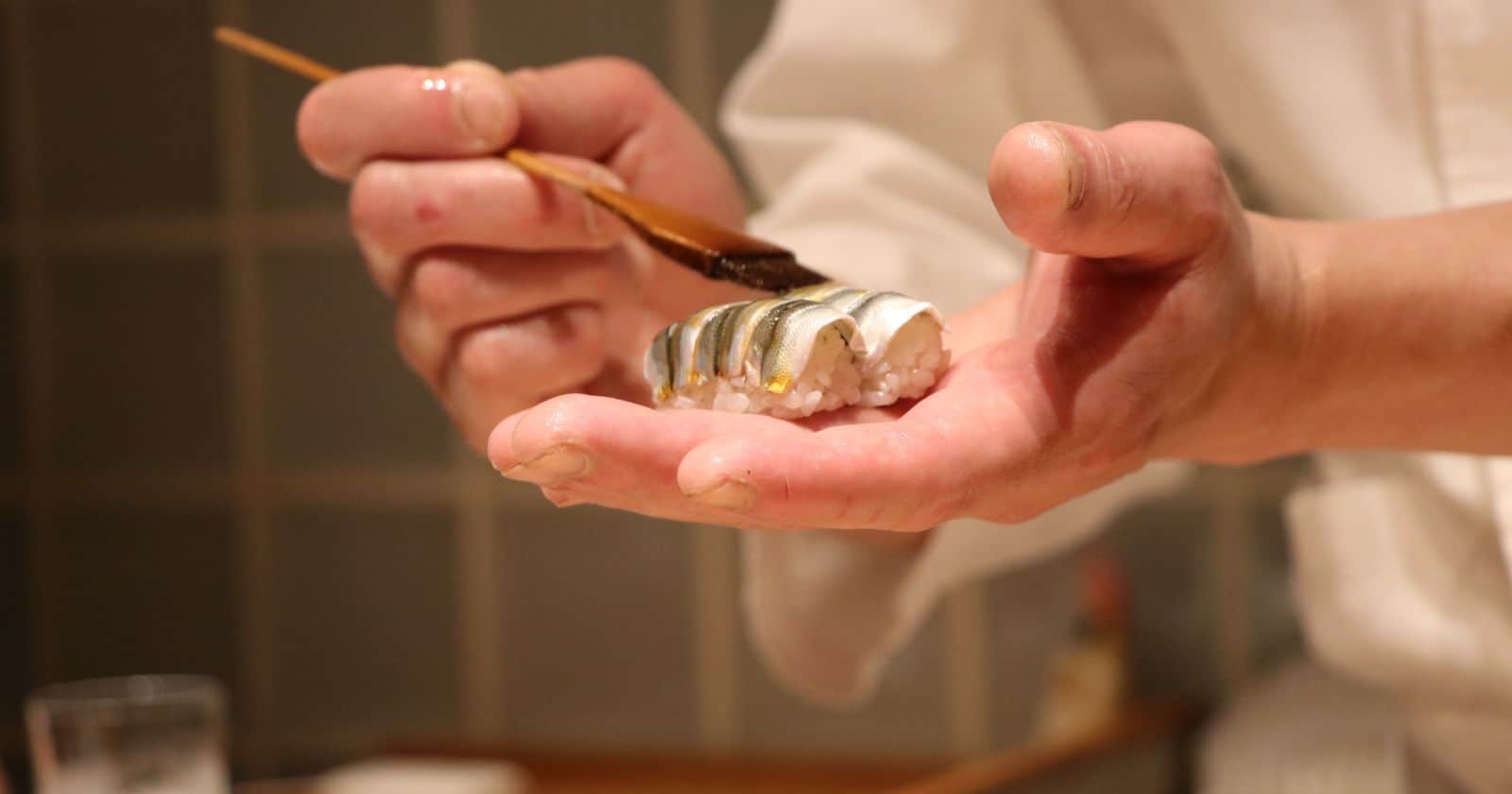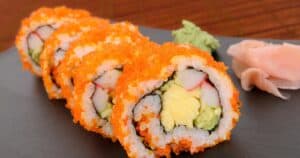What are sushi chefs called? The masters behind the sushi bar have a few special names.
In Japan, sushi chefs are respectfully called “itamae,” meaning “in front of the cutting board.” They train for years as “wakiita,” or “near the cutting board” before becoming full itamae.
It takes dedication to reach itamae status. Sushi chefs undergo intense apprenticeships to master ingredients and knife skills. With time, wakiita learn customer service skills while assisting their itamae mentors.
The terms itamae and wakiita reveal sushi mastery. Read on to learn more about these honed Japanese chefs and their sushi journey.
Itamae: The Sushi Master
In Japan, an accomplished sushi chef is known as itamae. This prestigious title translates to “in front of the cutting board.”
The itamae stands facing diners behind a wooden sushi bar. With graceful, economical motions, they transform raw fish into edible art using traditional knives and tools.
Earning itamae status requires intense dedication. Sushi apprenticeships last five years or longer. Aspirants are called wakiita until they have honed their skills.
Eventually, the wakiita receives promotion to itamae. This milestone grants them authority over the sushi bar and kitchen. The new itamae can now run their own restaurant.
The term itamae demands respect. These sushi masters have devoted themselves to their craft. Their knowledge encompasses fish varieties, flavor pairings, textures, temperatures and presentation.
Top itamae may source fish at Tokyo’s famous Tsukiji fish market. They handle million-dollar tuna auctioned before dawn. The freshest catches then become dinner in their capable hands.
Wakiita: Learning the Sushi Ropes
So how does one become an itamae? The long journey starts by becoming a wakiita.
Wakiita translates to “near the cutting board” in Japanese. These apprentice sushi chefs support the itamae behind the scenes.
The wakiita’s duties include daily preparation of fresh ingredients. They transform whole fish into sashimi-ready cuts. Wakiita also grate fresh wasabi, slice scallions, blend sauces and stock rice.
This tedious prep work builds knife skills over time. As wakiita advance in their training, they may begin preparing simple sushi rolls and pieces for takeaway orders.
The wakiita closely observes the itamae interacting with customers. They learn the proper etiquette of the sushi counter: gracious speech, efficient motions, calm demeanor.
After 3-5 years, the wakiita may gain promotion to sous chef. They continue honing their skills under the itamae’s watchful eye. If fortunate, the wakiita will one day earn the title itamae themselves.
Itamae vs. Sushi Chef: What’s the Difference?
In the western world, “sushi chef” is a looser term. It generally refers to anyone preparing and serving sushi at a restaurant.
For example, beginner sushi rollers are often called sushi chefs. So are the talented chefs meticulously plating nigiri at the sushi bar.
The prestige of “itamae” doesn’t fully translate outside Japan. Western diners are usually less familiar with the intense training the title represents.
Of course, accomplished sushi chefs outside Japan still undergo rigorous apprenticeships. But the terms remain less codified compared to the hierarchy in Japanese sushi culture.
So while a sushi chef can be anyone from entry-level to expert, itamae denotes a Japanese sushi master.
Sushi Chef Uniforms and Tools
Itamae and wakiita are easily spotted by their distinctive uniforms called montsuki. The formal outfit includes:
- Happi coat – A lightweight cotton indigo-blue or black jacket bearing the itamae’s name and restaurant logo.
- Fundoshi – A traditional loincloth underwear providing comfort and mobility.
- Tabi – Split-toed white socks allowing freedom of movement.
- Hachimaki – A headband to tuck hair away from face and food.
Beyond the uniform, specialized tools distinguish sushi chefs:
- Maguro bocho – A long, thin, razor-sharp knife for slicing tuna.
- Deba bocho – A heavy, single-beveled knife ideal for filleting fish.
- Makisu – A thin bamboo rolling mat for molding sushi rolls.
- Shamoji – A flat wooden paddle for scooping rice.
- Hangiri – A round, flat-bottomed wooden tub for seasoning rice.
- Mizusashi – A jar of water for moistening hands while shaping nigiri.
These specialized tools reflect meticulous Japanese craftsmanship. In the hands of a skilled itamae, they create edible art.
Sushi Chef Training: The Path to Itamae
Becoming an itamae takes intense dedication spanning years. The standards for education are incredibly high in Japan.
Here are some key phases of sushi chef training:
Sushi School
Aspiring sushi chefs start by completing a certificate program at a sushi school or vocational college. This provides a foundation in food safety, preparation and cooking methods.
Restaurant Apprenticeship
The real training begins by getting hired as an apprentice or “wakiita” at a sushi restaurant. Here they assist the itamae for 10-12 hours a day.
Fish Butchery
The wakiita learns to expertly butcher whole fish. This entails filleting, slicing and portioning various species.
Rice Preparation
Perfectly seasoned rice is crucial for sushi. Apprentices spend months learning proper rice washing, cooking, seasoning and molding.
Fish Aging
Certain sushi fish must age for days for optimal flavor and texture. The wakiita learns traditional aging techniques.
Knife Skills
It takes years to master the 100+ specialized sushi knives. Apprentices start with vegetables before progressing to fish.
Sushi Rolling
The wakiita practices rolling maki inside out, with the nori on the inside. This protects the seaweed from getting soggy.
Nigiri Shaping
Nigiri sushi is shaped by hand, requiring finesse. The rice must have the ideal temperature and moisture.
Fish Sourcing
Top itamae source only the freshest seafood. Apprentices learn how to select quality fish.
Customer Service
At the sushi bar, the wakiita learns etiquette and polite speech when interacting with diners.
Sushi Traditions
The origins and symbolism of Edomae sushi guide each ritual behind the sushi counter.
This covers just the basics. Some spend 10 years as apprentices before attaining itamae status. It’s a lifelong path of continuous improvement.
Women Sushi Chefs: Breaking Barriers
Traditionally, becoming an itamae was restricted to men. Sushi’s rigid hierarchy barred women from advancement.
But pioneering female chefs have broken barriers over decades of determination. Today, more women work toward earning itamae status and running their own sushi bars.
For example, Satsuki Nakao became Japan’s first female itamae in the 1950s. She eventually opened renowned restaurant Satsuki in Tokyo.
Californian sushi chef Daisuke Nakazawa featured prominently in the documentary “Jiro Dreams of Sushi.” In New York, her restaurant Sushi Nakazawa earned a Michelin star.
While discrimination persists, women continue entering the industry and rising to head sushi chef. Their skills and drive open doors for more female itamae.
Fusion Sushi Chefs: Evolution of Tradition
Sushi originated in Japan but has expanded far beyond. The cuisine keeps evolving as it spreads worldwide.
Today’s sushi chefs fuse traditional techniques with local ingredients and global flavors. For example, chefs may incorporate mangos, curry powder or spicy mayo into modern rolls.
Some traditionalists argue that radical departures from Edomae sushi dilute its purity. But fusion keeps sushi exciting and relevant across diverse cultures.
Daring sushi chefs could be the itamae of tomorrow. Their openness to experimentation moves sushi progressively into the future.
Celebrity Sushi Chefs: Superstars of the Sushi World
Certain celebrity sushi chefs have become famous ambassadors of their craft. While not all hold the rank of itamae, their sushi mastery has made them household names.
Jiro Ono – Subject of the documentary “Jiro Dreams of Sushi,” his minimalist Tokyo sushi bar Sukiyabashi Jiro earned 3 Michelin stars.
Masaharu Morimoto – Iron Chef and global restaurateur known for merging Japanese ingredients with western techniques.
Nobu Matsuhisa – Pioneer of “New-Style” sushi, his global Nobu restaurants popularized Japanese-Peruvian fusion.
Kazunori Nozawa – Patron saint of sushi’s globalization, his California chain Sugarfish is wildly popular for its “Trust Me” omakase menus.
Yoshihiro Narisawa – Avant garde itamae fusing Japanese tradition with molecular gastronomy at his Tokyo restaurant Narisawa.
Their unique styles and celebrity cachet showcase sushi as a dynamic, ever-evolving cuisine.
Respecting the Sushi Master
Sushi culture centers around respect for ingredients, traditions and the itamae. Diners at the sushi bar treat the chef with deference.
Here are some tips for respecting sushi chefs:
- Allow the itamae to guide you through the omakase meal.
- Avoid requesting extra sauces or mixing wasabi directly into soy sauce.
- Never point your chopsticks at the itamae, which is considered rude in Japan.
- Tip at least 15-20%, or more for exceptional service.
- Engage politely with itamae if they welcome conversation.
- Thank the itamae sincerely for their artistry and hospitality.
Showing courtesy acknowledges the decades of training behind the sushi bar. The itamae keeps time-honored traditions alive with each perfect piece crafted.
The Finely Honed Specialist
The titles itamae and wakiita represent mastery of an ancient craft. They set Japanese sushi chefs apart for their rigorous dedication and skill specialization.
Next time you visit a sushi bar, consider the journey it took to turn fresh fish and rice into edible jewelry. Tip your hat to the chef’s refined expertise that elevates each bite into a memorable experience.
Itadakimasu!





